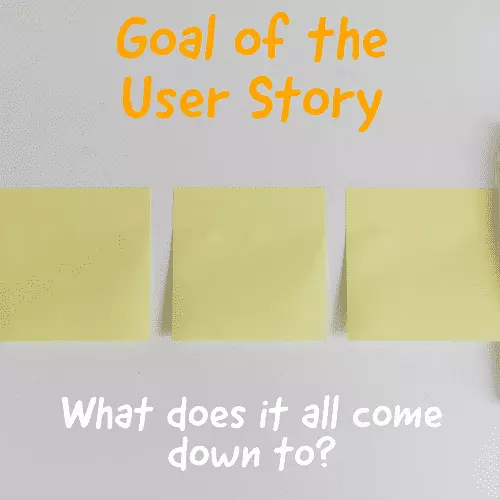
What is the goal of the user story in Agile development? You may have written user stories yourself. Maybe you have seen the concepts used to help write user stories. But what is the fundamental goal of the user story? What problem are you solving, by use of a user story? Quite simply, it boils down to communication! The user story is a method of communicating needs and goals. And a way to prompt conversations to happen, to go meet goals.
The goal of the user story all starts with communicating!
This communication drives the work of the team. The typical format is “As a _____, I need or want _____ so that some outcome happens”. Defining in this manner helps paint a clear picture of the goal. You have an actor. The actor has a need or want. Then, by meeting that need or want, you achieve some outcome. Outcome being of primary importance. As enabling delivery of work, helps meet the outcome. You meet the outcome only by understanding the need.
User Story And Requirements
A user story is a form of a requirement. Its a newer and better form. Tailor it to your needs. Use it to achieve your needed outcomes. Traditional requirement practices list out work to be done. The method and format caused a lack of context. It also failed to communicate the outcome of the work. It strictly said, “go do these things”.
You missed out on the opportunity to understand why you should do those things. An improvement with agile processes, is showing that context around the work. Give more context into why you do the work with the user story. Use context to enable goals to be achieved.
Working towards goals to achieve outcomes is also an improved approach over following requirements. Goals show the endgame you want. They help illustrate a path for the team. Even if that path has to have details figured out by the team. The team understands the direction they are moving and where they want to go.
The alternative, following more requirements, doesn’t illustrate goals. It doesn’t allow for the team to best create their path forward, to achieve said goals.
When To Re-Examine The Goal Of The User Story
Re-examine user stories when you do not achieve desired outcomes. Consider the content, and how you write it. If you do not achieve goals, its because you are not communicating goals. When this happens, consider your user story, looking for improvement.
There is no one right way to write a user story. However, it’s important to listen to new ideas from the team. Include their preferences and to be willing to experiment. If I had never tried a new idea, I never would have improved. Include team feedback to grow ideas of the user story. User stories are important because of the context and goals they provide. Better understanding of those goals and context comes from a diverse team.
There is also negotiating on the scope of the user story. Without negotiating, the team does not feel like they have input. Without input, you negatively impact the team.
There are opportunities for innovation all around. Found in the design, functionality, and make-up of our products. Also in the processes we use, as well as in the stories we write. It doesn’t mean that vast amounts of time should be spent changing how one writes user stories. Especially when a team finds a good working equilibrium, but I hope this article helps when it is the right time to take a look.
Building Shared Understanding
The user story will help you and the team to understand the work to be done. It is a way of communicating a need. As well as giving context to the work. The team takes it from there to build a shared understanding. The shared understanding by the team is a key component of the team working the story.
The team builds and adds information together, adding to the sum total of their understanding. The team members all have valuable information to contribute. You get a better solution to the work needed when you combine team knowledge.
Shared understanding by the team also helps the team to distribute work. Allowing you to share pieces of the work amongst the team. Team members can better distribute work if they have a shared understanding. A shared understanding of the work also helps enable swarming on work. Consolidate the team around important work to complete it faster. Let the team self organize on the work itself.
Ultimately, The Goal Of The User Story Is To Begin The Work
The agile user story has the ultimate goal of starting the work. It will not necessarily give the team all of the info needed to do the work. It gives the team enough info to begin the work. The team takes the story as a starting point. Then they obtain the needed info to achieve the desired outcome. Well practiced agile teams understand this process. Those teams know the best solutions come from the shared understanding of the team. When that team works towards a goal, starting from the user story. Thus a goal of the agile story is to prompt the work to begin.
Conclusion:
There are no best practices for agile user stories. Especially nothing that works universally. It varies because of differing people, technology, and products. When writing requirements, there are numerous methodologies available. Use the agile user story as a base process, to help drive the work. You can also use it as a complement to many other methodologies. Regardless of the methods and process used, the user story is a tool to help communicate.
Lastly, the goal of the Agile software user story is to communicate. When you communicate well, you can be successful. The user story is a means of communicating information. Use it as such, as a tool to achieve outcomes. Like any form of communication, the user story takes work and practice. Remember, keep the goals of your work in mind. Practice writing informative and clear agile user stories. These will help you with the goal of the agile story.
Additional reading and ebooks that help understand the goal of the user story
Vertical Slicing and Just in Time Reqs are 2 huge practices that help build the user story. And when understand the reasoning behind these practices, you start to understand the goal of the user story.


